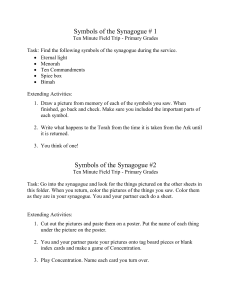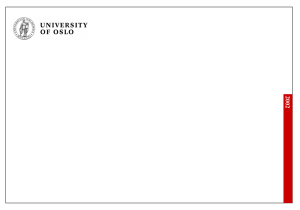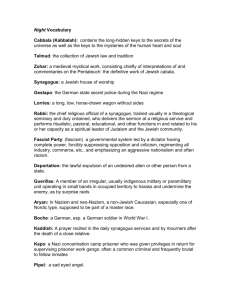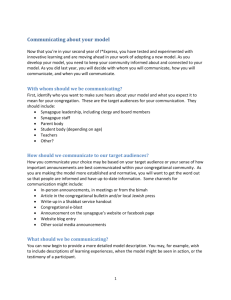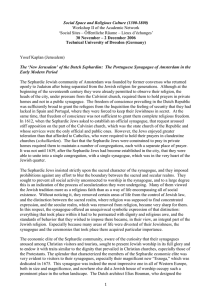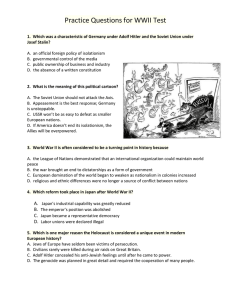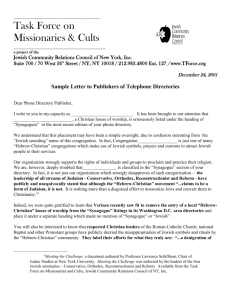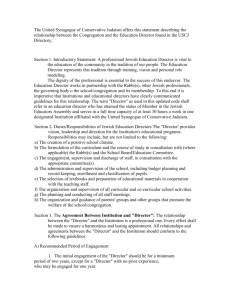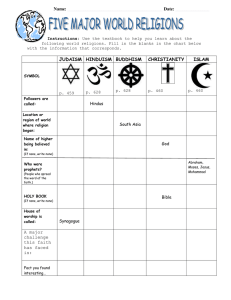The Question of Music in American Judaism:
advertisement
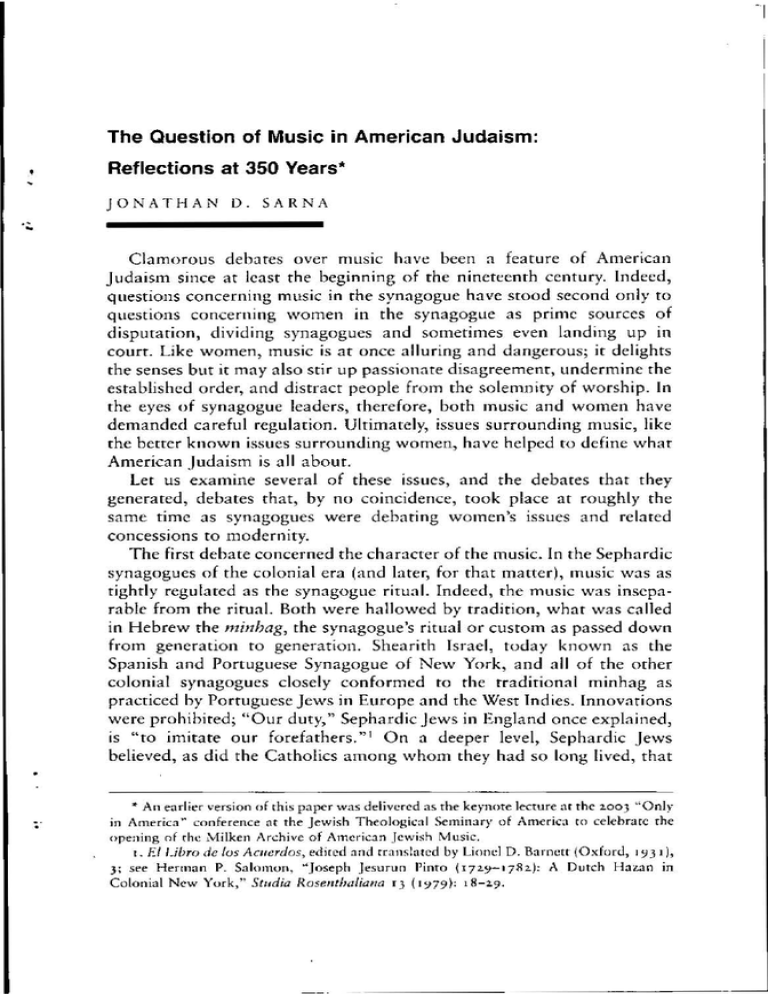
-I
The Question of Music in American Judaism:
Reflections at 350 Years*
JONATHAN D. SA R NA
·;;.
Clamorous deba tes over music have been a feature of American
Judaism since at least the beginning of the nineteenth century. Indeed,
questions concerning music in the synagogue have stood second on ly to
questions concerning women in the synagogue as prime sources of
disputation, dividing synagogues and sometimes even landing up in
court. Like women, music is at once alluring and dangerous; it delights
rhe senses but it ma y also stir up passionate disagreement, undermine the
established order, and distract people from the solemnity of worship. In
the eyes of synagogue leaders, therefore, both music and women have
demanded careful regulation. Ultimately, issues surrounding music, like
the better known issues surrounding women, have helped to define what
American Judaism is all about.
Let us examine several of these issues, and the debates that they
generated, debates that, by no coincidence, took place at roughly the
same time as synagogues were debating women's issues and related
concessions to modernity.
The first debate concerned the character of the music. In the Sephardic
synagog ues of the colonial era (and later, for that matter) , music was as
tightly regulated as the synagogue ritual. Indeed, the music was inseparable from the ritual. Both were hallowed by trad ition, wha t was called
in Hebrew the minhag, the synagogue's ritual or custom as passed down
from generation to generation. Sheari th Israel, toda y kn own as the
Spanish a nd Portuguese Synagogue of New York, and all of the other
colonial synagogues closely conformed to the traditional minhag as
practiced by Portuguese Jews in Europe and the West Indies. Innovations
were prohibited; "Our duty," Sephardic J ews in England once expla ined,
is "to imitate our forefathers. " 1 On a deeper level, Sephardic Jews
believed, as did the Catho lics a mong whom they had so long lived, that
• An earlier version of this paper was delivered as the keynore lecrure ;I! the 2.003 "Only
in America " conference nt the j ewish Theologi<:al Seminary of America w celebrate the
opening of the Milken Archive of American Jewish Music.
1. E/ Lil>ro de Iu s A cuerdos, ed ited nnd translated by Lionel D. Barnett (Oxford, 193 1),
3; see Herman P. Salomon, •'Joseph Jesurun l'inro (172.9-1782.): A Dutch Hazan in
Colonial New York," Studia Roselltlmliana 13 ( 1979): 1 8-2.9.
196
A M ER I C A N
J E W I S H
H I S T 0 R Y
ritual could unite those whom life had dispersed. They wanted a member
of their Nation, as they called it, to feel at home in any Sephardic
synagogue anywhere in the world: the same liturgy, the same customs,
and the same music. As late as 1841, a president (parnas) of Shearith
Israel articulated the synagogue's ideology in response to those who
sought to change it: "Let any of us, arriving from almost any part of the
world, meet," he declared, "we feel ourselves at home, and join in the
service of the synagogue, on any day, at any time, even to the different
tunes." 2
Fortunately for colonial jews, many local Protestant churches were
equally conservative in their musical traditions. "Established texts and
known tunes were essential to the worship" of most colonial churches,
"while non-verbal utterance, musical improvisation, individual spontaneity, and liturgical flexibility were generally absent." 3 The Congregational church in Weston, Massachusetts, in 1724 reflected local custom
when it approved a list of fourteen tunes to be used in its worship, and
warned the chorister co use no others " unless he has further order from
the Church. " 4 Churches, like their synagogue counterparts, promoted
the virtues of tradition, regularity, and order through their choice of
what to sing. just as men, women, children, and slaves all had a fixed
and carefully determined place in God's house, so too did sacred music.
The late-eighteenth and early-nineteenth centuries witnessed a whole
series of innovations in American religious life: the great Protestant
awakenings, disestablishment, church-state separation, the rapid growth
of new denominations, and the like; and unsurprisingly, these produced
changes in music as well. The same revolutionary spirit-the so-called
contagion of liberty-that affected so many other aspects of life, also
unleashed demands for innovation in liturgy and song; parallel developments, of course, were taking place in Europe. Initially, the synagogue
resisted such innovations and attempted to impose discipline. "Every
member of this congregation shall, previous to the singing [of] any
psalm, or prayer, remain silent until the [Hazzan] shall signify the tone or
key, in which the same is to be sung," an 1805 by-law of Shearith Israel
declared. "Those who are so inclined may then join therein, with an
equal voice, but neither higher or louder than the Hazzan. " 5
2. David de Sola Pool and Tamar de Sola Poo l, An Old Faith in the New World:
Portrait of Shearith Israel, 1654-1954 (New York, 19 55), 99·
3· Nym Cooke, "Sacred Music to r8oo," The Cambridge History of American Music,
ed. David Nicholls (Cambridge, r998), 82.
4· As quoted in Cook, "Sacred Music to I 8oo," 91.
5· j oseph L. Blau and Salo W. Baron, cds., The jews of the United States: A
Documentary History, 1790-1840, 3 vols. (New York, 1963), 2 : 520.
•
•
J.D. Sarna: The Question of Music in American Judaism
.
..
197
In 1818, however, we find a proposal by "a number of Young
gentlemen of the Congregation, who proposed forming a class, with a
view to improving the Singing of the Synagogue. " A century earlier, such
singing schools had precipitated dramatic changes in Protestant sacred
music, setting the stage for trained choirs, art music, and a gradual shift
away from a participatory liturgy and toward a more performanceoriented one, led by the musically gifted. In a controversial opinion,
however, a committee of Shearith Israel leaders warned that "all
innovations on customs and forms established for a long series of years ...
should be approached with great caution and deference." Without
entirely rejecting the idea of a music class, they warned against "discord
in shoo!, by some singing who have been under rehearsal, & others
endeavouring to drown their Voices who have not had an opportunity of
attending the rehearsal and who may disapprove of a select number
singing in shoo!. " 6 Articulated here is the fear that music might become
a divisive force within the synagogue, undermining established norms
and resulting in the creation of a musical elite that would in time seize
control of the divine worship.
Tempora rily, then, the " Young gentlemen " of the congregation were
thwarted. Music, however, remained a focal point of controversy in
Shearith Israel, a vehicle for expressing tensions between tradition and
change. When a new hazan, Isaac Benjamin Seixas, was appointed in
I 828, he was specifically warned not to introduce into the synagogue
"any profane melodies or those used in Christian churches," a sure sign
that some wanted to liven up synagogue worship with just those kinds of
tunes/ Seixas was also warned not "to set ... the tone or key so high as
to preclude the Congregation from taking part in the singing, and
thereby causing disorder and confusion," again an indication that music
in the synagogue had become a battleground, in this case between a
musically talented hazan and congregants more interested in group
singing than in performance. 8 In the context of their day, however, these
seemingly superficial a nd inconsequential disputes over synagogue music
really reflected deeper disputes that touched at the heart of synagogue
life, including such issues as cultural absorption (selective borrowing
from the surrounding culture) versus cultural retention, and participatory worship versus performance-oriented worship. Indeed, in arguing
-..
6. Ibid., ;1.: 494-96; see Pool and Pool, An Old Faith in the N ew World, 152--53·
7· Pool a nd Pool, Mz Old Faith in the New World, 178.
8. Ibid., T54·
198
AM E R I C A N
J E WI S H
H I S T 0 R V
over the kind of music that they wanted to hear, congregants were really
arguing over the kind of Judaism that they wanted to experience. 9
The petition of the "Young gentlemen" of Shearith Israel in r8r8
points us to a second area of debate within American Judaism. Beyond
the question of what music to sing, there was also the question, already
alluded to, of who should sing the music. Colonial Jews, like their
Calvinist neighbors, believed in general and unregulated participation, or
what we would call communal singing. Men and women sang together
in Sephardic synagogues: the women above and the men below. This
practice initially influenced some immigrant congregations. Joseph Jonas,
in his lively 1843 memoir concerning the founding of the Jewish
community of Cincinnati, provides us with a particularly rich account of
musical traditions in the congregation that he helped to found in r824,
known as Bene Israel (today, Rockdale Temple). "The original founders
of our congregation," he wrote, "were principally from Great Britain,
and consequently their mode of worship was after the manner of the
Polish and German Jews; but being all young people they were not so
prejudiced in favour of old customs as more elderly people might have
been, and especially as several of their wives had been brought up in
Portuguese congregations [that, incidentally, is a significant comment; it
sheds light on the Sephardic practice and how it spread to Ashkenazi
synagogues]." He continued:
We therefore introduced considerable chorus singing into our worship in
which we were joined by the sweet voices of the fair daughters of Zion, and
our Friday evening service was as well attended for many years as the Sabbath
morning. At length, however, large emigrations of our German brethren
settled amongst us; again our old customs have conquered and the sweet
voices of our ladies are seldom heard; but we have so far prevailed as to
continue to this day, the following beautiful melodies: the 29th Psalm
[Mizmor Ledavid] which is chaunted as the procession slowly proceeds to
deposit the Sepher Torah in the ark; also Ein Kelohenu and after the service is
concluded none attempt to quit their seats until the beautiful hymn Adon
Olam ... is finished, being sung by all the congregation in full chorus.
9· These debates never reached a final resolution. See, for example, the findings of a
1973 survey at Congregation Beth Israel in Houston (Reform) concerning the musical
content of that congregation's liturgy: "Half the people want the format left exactly as it is
and half want it changed." As quoted in Kay Kaufman Shelemay, "Music in the American
Synagogue: A Case Study from Houston," in The American Synagogue, ed. Jack
Wertheimer (Hanover, NH, 1987), 405.
.
'
J .D. Sarna: The Question of Music in American Judaism
.,
•
199
Jonas's account, among many other things, introduces us to the theme
of gender, the question of whether women 's voices should be heard in the
synagogue-one of the many women's issues linked directly or indirectly
to questions concerni ng music. In different ways, debates over women's
voices in the synagogue would continue down to contempora ry times,
taking the form of such questions as: Can women sing in a choir? Can
women serve as cantors? And ca n female voices tkol isba} be heard at
all? Jonas's account also charts the gradual elimination of congregational
singing, which over time became restricted in many places to a few set
pieces surrounding the Torah service and at the conclusion of the liturgy.
The bulk of the music in large synagogues was taken over by trained
singers, the most significant mid-nineteenth-century innovation being the
introduction of the choir. This change is traditionally dated to 1845,
when a regular choir of men and boys was organized at Temple EmanuEl in New York, but we know of occasional choirs as early as the r82os,
and there is some evidence of a regular mixed choir at Beth Elohim in
Charleston a few years before. 10
In Judaism, as in American Protestantism, the introduction of choirs
transformed worship. Henceforward, congregants were instructed to "be
perfectly silent," or at the very least to recite prayers " in a low tone of
voice so as not to interfere with the H aza n or Chorus, and in no case to
disturb the worship." The choir, in effect, diminished the role of
congregants, who became passive auditors o f the service. Karla Goldman
points out that choirs likewise deprived men of their proprietorship over
the worship and, ironically, placed them closer to the traditional [nonparticipating] synagogue position of wo men. 11
The benefit of the choir, in addition to the quality of its music, was its
role in promoting a new atmosphere within the synagogue, one characterized by reverential awe. In America, as in Germany, choir music
combined with grand styles of synagogue architecture, forma l garb, and
an enhanced emphasis on decorum to shape a refined, elevated atmosphere, one that reflected Jews' rising status in society and sought to
bestir worshippers to high-minded thoughts, introspection, and moral
improvement. Mid-nineteenth-century Jews, influenced by their highchurch neighbors, considered this to be the essence of religion, and they
10. Irving H. Cohen, "Synagogue Music in the Early American R epublic, ~ Gratz
College Amtual of j ewish Studies 5 ( r ~q6): 20, bur see n.24 where he concedes that the
choir ar Charlesron 's B~th Elohim was ea rlier; sec a lso Occident 2. (April 1 844 ) available at
www.jewish-history.com/Occidcnt/volume2/aprilr844/charlcston.html.
1 J. For the quotes a nd the analysis, see Karla A. Goldman, Beyond th e Synagogue
Gallery: Finding a Place for Women in American Judaism (Cambridge, 2000), 87- 88.
200
AMERICAN
JEWISH
HISTORY
optimistically believed that, through the creation of this new atmosphere
within the synagogue, the image of Judaism would be improved, a new
era would dawn, and anti-Judaism would disappear. To take just one
example among many, New York's new Shaaray Tefilla synagogue, the
most magnificent to that time, was portrayed in the Occident following
its 1847 dedication (a dedication, by the way, where much music was
performed) as a place where a Jew felt himself "proud at being an
Israelite," conscious that he was "but an atom in creation, yet still an
instrument in God's hands," and finally a place where "being one of His
chosen was made manifest in the sight of the Gentiles." 12
Choirs never fully resolved the question of who should sing in the
House of God. Traditionalists insisted that only male voices should be
heard, although they also admitted prepubescent boys into the choir to
allow the music to soar into the higher ranges. Reformers insisted that
both men and women should be admitted into the choir, and some made
their peace with non-Jewish choristers as well, so long as their glorious
voices created an atmosphere conducive to awe-inspiring worship. A
generation later, both traditionalists and reformers partially reversed
themselves, promoting full congregational participation in at least some
synagogue singing for fear that too passive a service was driving
congregants away. These raging tensions-between participation and
performance, between congregational singing and choir music, between
the demands of tradition and the allure of modernity-never could fully
be resolved. They reflected deep-seated differences over aesthetics, over
prayer, and over Jewish law that continue to divide American Jews from
one another to the present day.
The third and perhaps most famous of the great debates over
synagogue music concerned instrumental accompaniment of musicwhat might be called the great organ controversy. Organs had first
appeared in America in churches early in the eighteenth century. Their
glorious tones promised to harmonize cacophonous congregational
singers and drown out noise. Even more than choirs, organ music was
also designed to inspire worshippers with a reverential sense of awe,
bestirring them to moral improvement.
Jews, of course, traditionally eschewed instrumental music in the
synagogue, just as English Puritans, early-American Lutherans, and
Scottish Presbyterians barred it from their churches. Jewish law strictly
12. Occident 5 (August 1847), on-line at www.jewish-history.com/Occident!volume5/
augi847/shaaray.html; see Michael A. Meyer, judaism Within Modernity: Essays on
jewish History and Religion (Detroit, 2001 ), 223-38.
J.D. Sarna: The Question of Music in American Judaism
201
enjo ined the playing of musical instruments of any kind, even at home,
on the Sabbath and holidays. But in nineteenth-centur y Germany, based
in parr on Jewish precedents from Italy and Prague, the pioneers of
Reform j udaism introduced the organ into their "temples," believing
that the instrument could promote the kind of refined and uplifting
spiritua l experience that they associated with modern worship. On both
sides of the Atlantic, the organ became in time a visible and audible
marker of Reform, dramatically distinguishing the new mode of Jewish
worship from its traditional counterparts. n
T he first known proposal to introduce an organ into an American
synagogue came in 1840, just as the members of Charleston's Beth
Elohim were completing a magnificent new building in the Greek Revival
style (the congregation's former building, on the sa me site, had burned to
the ground in 18 3 8). 14 Thirty-eight members, seeking to extend the spirit
of innovation represented by the new building, and, in their own words,
" an xious to embrace ever y laudable and sacred mode by which the rising
generation may be made to conform to and attend our holy worship,"
petitioned for a congregational meeting " to discuss the propriety of
erecting an organ in the synagogue to assist the vocal part of the service. "
The congregation's popular minister, Gustavus Poznanski, a native of
Prussian Poland and hi mself an able m usician, sanctioned the innovation
of an organ on religious grounds, and with his blessing the congregation
voted forty-six to forty in fa vor of installing one. The reformers having
won the day, the traditionalists, particularl y those born abroad, left to
form a new congregation, Shearirh Israel. That name, which would
subsequently be adopted by various other breakaway traditional congregations in the nineteenth century, establis hed an eponymous link between the local traditionalists and New York's pioneering Sephardic
synagogue. It a lso reflected the traditiona lists' sense of themselves as a
surviving "remnant of Israel. "
Within a few months, moderate refo rmers, alarmed at the ra pid
cha nges that their more radical brethren were making in the liturgy, and
alar med by Rev. Poznanski's open declaration that " he knew no stopping
1 3. R.J .Stanislaw, "Musical Instruments in Churches," in Dictionary of Christianity in
America, ed. Daniel G. Reid et al. (Downers Grove, Ill. , 1990), 790; Meir Benaya hu,
" Da'a t Hakhmc ltalya AI Ha-Neginah B-Ogev Be-Tfila h," Asufot 1 ( 19ll7): 265- 3 r8.
14. For what follows, see Allan Tarshish, "The Cha rleston Organ Case," American
jewish Historical Quarterly 54 ( 196 5 ): 4 1 1- 49; Willia m J. Hagy, This Happy Land: The
jews of Colo11ial and Antebellum Charleston (Tuscaloosa, 1993), 24o-56; Michael A.
M eyer, Respottse to Modernity: A History of the Reform M ovement in judaism (New
York, r988), 233- 35 .
202
AMERICAN
JEWISH
HISTORY
place to Reform in this enlightened age," joined forces with Shearith
Israel's members and endeavored to recapture the leadership of Beth
Elohim. Their aim were to check the "great and growing evil" of reform,
to abolish the organ, the quintessential symbol of innovation, and to
"restore concord and harmony." A complicated legal struggle ensued,
and for the next three years the battle shifted to the courts. 15
In Europe, judicial and government intervention generally spelled bad
news for advocates of Jewish religious reform. 16 But in Charleston the
result was different. The legal precedent set forth in the so-called
"Charleston organ case" and subsequently upheld on appeal, significantly affected the course of Judaism in America by establishing that
"questions of theological doctrine," and issues such as whether a
synagogue may accompany its music with an organ, should not be
decided by the courts at all. "Matters of that kind," Judge A.P. Butler of
the Court of Appeals declared in r846, "must necessarily belong and
should be committed, to the jurisdiction of the body that has the right of
conducting the religious concerns of ecclesiastical corporations" -meaning, in the case of Judaism, the individual synagogue's own board of
trustees. The court also determined that "in a country where toleration is
not only allowed, but where perfect freedom of conscience is guaranteed
by constitutional provision," religious change was inevitable. No synagogue charter, the court declared, could establish "the exact kind of
music that was to be used in all future time." 17
The court's ruling made it all but impossible to mount a successful
legal challenge against a majority bent on reforming traditional Jewish
practice through organ music, mixed seating, or other means. Proponents of religious reform could proceed virtually without fear of legal or
governmental challenge, while proponents of Jewish tradition could win
only by persuasion, not by appealing to courts of law. Henceforward,
questions concerning music in the synagogue would be decided just like
so much else was in America: by majority rule.
More than previous disputes over music (disputes over the type of
music to be played or disputes over choirs), the organ dispute also clearly
separated Reform Jews from their opponents, who in response began to
call themselves "Orthodox." The terms "Orthodox" and "Orthodoxy,"
15. Meyer, Response to Modernity, :t34; Tarshish, "Charleston Organ Case," 435,
438.
16. Meyer, Response to Modernity, 52.; Anne J. Kershen and Jonathan A. Romain,
Tradition and Change: A History of Reform Judaism in Great Britain, 1849-1995
(London, 199 5}, 39-4I.
17 . Tarshish, ~charleston Organ Case," 439- 45.
J.D. Sarna: The Question of Music in American Judaism
203
scarcely known in American Jewish life before 1840, turned up repeatedly thereafter. Indeed, Orthodox became the term of choice for Jews
who opposed the Reform innovation of the orga n, and advoca ted what
they called "true adherence to our holy religion in its ancient form." 18
With in a generation, the organ, a long with mixed seating, became visible
a nd audible boundary markers separating O rthodoxy fro m Refor m.
T hus, unlike colonial Jews, who had hoped that their repertoire of
Sepha rdic synagogue music, severely regulated and limited by tradition,
would unite the American Jewish community, late-nineteenth-century
Jews fo und that music had come to represent all that divided J ews from
one another. Much like the better known questions surrounding women
in the synagogue, questions concerning mus ic in the synagogue-what
music is app ropriate, who may sing that music, and whether the music
may be accompa nied by instruments- helped to shape the very nature of
American Judaism, in all its pluralistic glory.
rll . Occident 3 {Aprilt S45): 5 {May 1847); I have used the on-line versio n available at
http//www. jewish-history.com.occident (search under "Orthodox," "Orthodo xy" ).
